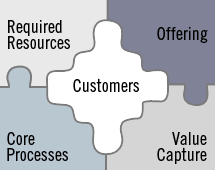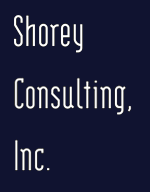Shorey Consulting works with businesses to identify and implement programs for profitable growth

Philosophy
Growth paths based on a sound, coherent business model are easiest to align an organization around and, thus, are the easiest to implement
Approach
Shorey Consulting works with organizations to craft business models based on the needs and values of customers and founded on customer, market and financial analysis
Once an organization has a business model, the hard work of attaining alignment throughout an organization begins
Shorey Consulting partners with organizations to build internal alignment through the strategy development process and through continuing coaching and support
| Software and Business Services Company |
| Situation |
A leading provider of software and outsourced business services created a new Group from multiple existing operating divisions. The challenge was to build an overall vision and direction for the new business. How did the various pieces fit together? What was the overall direction? |
| Approach |
Develop basic data to define the broad industry from the customer's perspective. Have the Group staff develop a consensus vision for which businesses they chose to be in. Communicate vision to operating divisions. Guide the operating divisions on their individual strategic directions. |
| Result |
New Group staff has successfully taken control of business and is now changing direction of operating units to improve total returns. |
| Industrial Equipment Company |
| Situation |
An industrial products conglomerate created a new Group from existing and acquired companies. The challenge was to build an overall vision and direction for the Group. How did the Group create value? |
| Approach |
Work in two track approach with the operating divisions and the Group to develop visions and to identify how the operating businesses could create common programs. Use a series of workshops with each division to develop vision and overall strategic direction. |
| Result |
Group developed a vision to guide future acquisitions. Divisions began to reset direction based around common skills. |
| Private Equity and Venture Capital Due Diligence |
| Situation |
Private equity and venture investors need to assess business models before making investment decisions. Is this a good business to invest in? Is there a cogent concept for success? What are the likely revenues and gross margins? |
| Approach |
Identify existing business model. Determine prime customer targets and values they desire. Assess competitiveness of target company. Project revenus and gross margins. suggest means to improve growth prospects. |
| Result |
Recognition of intrinsic business value. Avoid focusing on minor faults. Focus on how to create further value to support necessary purchase price. |
| Early Stage Company Business Model |
| Situation |
Early stage companies need clear, cogent business models to guide investment of time and money. What customers will it focus on, what will it offer, how will it get paid, what functions does it need to do itself? |
| Approach |
Work with early stage company to define core elements of business model. Where necessary, craft business model case into a business plan to guide investment and fundraising. |
| Result |
Ability of management team to work together in a coherent manner, all focusing on defined objectives. Ability of management team to avoid distractions in product development, customer targeting and chimerical revenues/contracts. |
| Process Control Company |
| Situation |
A large provider of industrial process control equipment faced major changes in its marketplace as its core mechanical technology was coming under increasing attack by electronics. How should the traditional industry leader respond? |
| Approach |
Develop core fact base on customer needs and comparative user economics. Work with client team to determine how quickly industry could evolve. Develop and select a response option. |
| Result |
Determined that non-economic maintenance issues would retard the adoption of electronics. Developed programs to use strength in existing distribution to maintain share. Created programs to adopt new technologies. |
| Building Materials Company |
| Situation |
Second-tier supplier of home remodeling products needed to create major, step-function increase in size and profitability. However, overall trends in its business were slowly becoming more difficult. Where could value be created? |
| Approach |
Develop core fact base on customer needs and comparative user economics. Work with client team to determine how quickly industry could evolve. Develop and select a response option. |
| Result |
Refocused sales attention from retail distribution, which offered high volumes but declining margins. Initiated efforts to create new, direct sales distribution channel. |
| High-Tech Materials Company |
| Situation |
Private investment company sought to acquire a producer of an apparently commodity material for the printed circuit board industry. How could the company produce value over time? |
| Approach |
Conduct external research on industry trends and customer requirements. Project future cash flows. |
| Result |
Investment company acquired producer and is investigating acquiring European joint venture. |
| Electric and Gas Utilities |
| Situation |
Several electric and gas utility companies have sought to build unregulated businesses in consumer and industrial services. What is necessary to create value? |
| Approach |
Develop fundamental fact base on customer needs. Determine key issues for successful implementation. Work with management teams to develop growth plans and implementation/roll-out programs. |
| Result |
Two clients are now expanding their service businesses in their own territories and preparing to expand into other geographic areas. |
| Large Chemical Company |
| Situation |
A major chemical company sought to create value from past R&D projects and from its analytical chemistry laboratory. What value existed in these assets? |
| Approach |
Develop fundamental fact base on customer needs. Determine value of the existing assets to customers. Develop plans to utilize the existing assets in commercial ventures. |
| Result |
Limited effort to market laboratory services coupled with substantial re-marketing of the labs within the chemical company. Rollout programs and joint venture activities for other R&D projects. |
| Restaurant Food Distributor |
| Situation |
A large distributor of food to restaurants was marginally profitable. It believed that some customers were unprofitable and dragged down the whole business. Which customers were profitable, why and what could be changed to improve profitability? |
| Approach |
Determine activity based costs. Determine profitability by customer and customer group. Develop repricing and other proposals. |
| Result |
Sales focus shifted to smaller but more profitable accounts. Large account discounts reduced. Programs developed to make more effective use of outside sales staff. |
| Electronic Control Equipment Supplier |
| Situation |
A manufacturer electronic controls sold through two different channels and faced competing internal claims to a major new product line. Which channels should it pursue, why and how should it make the necessary changes? |
| Approach |
Create team from both internal groups to develop fact base on actual overlap in the marketplace between customers. Determine that the overlap was minimal, allowing agreement between the two internal groups to share the product line, ending years of internal conflict. |
| Result |
Product line successfully launched by both groups including presentation to independent distributors on their requirements in order to maintain access to the product line. |

